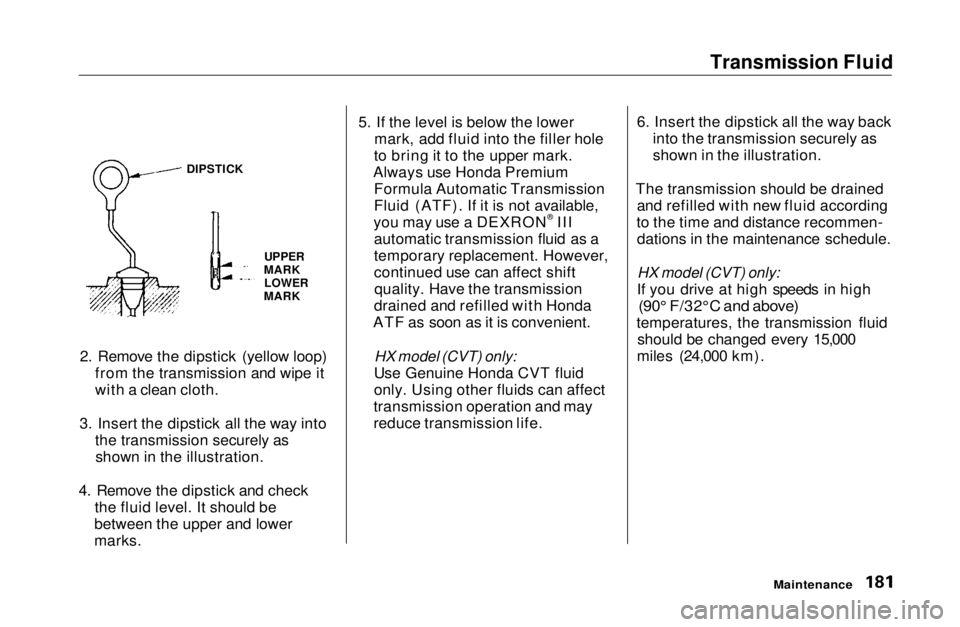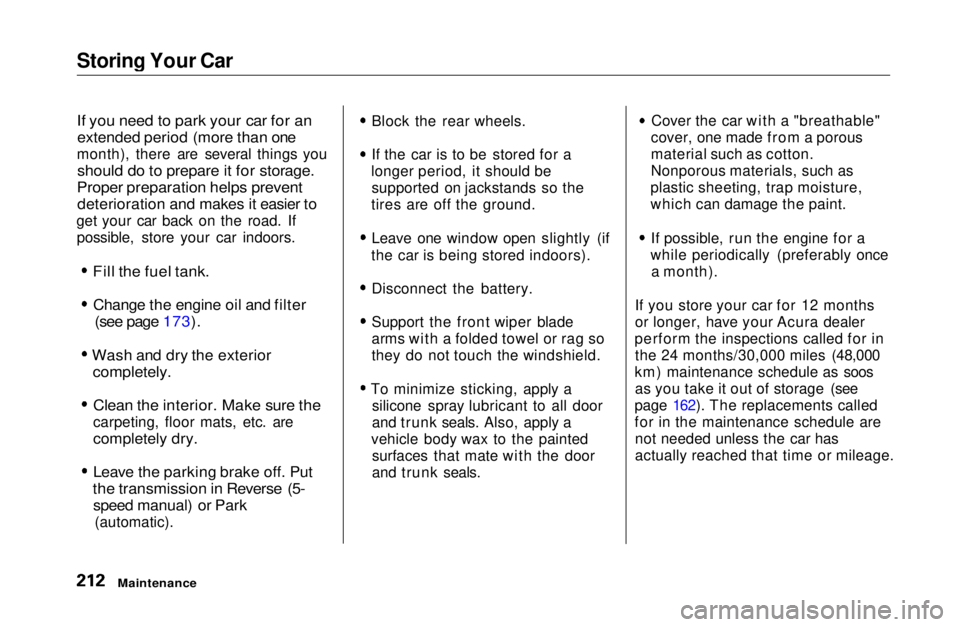Page 172 of 269

Engine Oil
Changing the Oil and Filter
Always change the oil and filter according to the time and distance (miles/kilometers) recommenda-
tions in the maintenance schedule.
The oil and filter collect contami- nants that can damage your engine if
they are not removed regularly.
Changing the oil and filter requires
special tools and access from
underneath the car. The car should
be raised on a service station-type
hydraulic lift for this service. Unless
you have the knowledge and proper equipment, you should have this
maintenance done by a skilled
mechanic.
1. Run the engine until it reaches
normal operating temperature,
then shut it off.
2. Open the hood and remove the engine oil fill cap. Remove the oildrain bolt and washer from the
bottom of the engine. Drain the oil into an appropriate container. 3. Remove the oil filter and let the
remaining oil drain. A special
wrench (available from your Honda dealer) is required to
remove the filter.
4. Install a new oil filter according to instructions that come with it.
CONTINUED
Maintenance
WASHER
OIL DRAIN BOLT OIL FILTERMain Menu Table of Contents s t
Page 180 of 269

Transmission Fluid
2. Remove the dipstick (yellow loop) from the transmission and wipe it
with a clean cloth.
3. Insert the dipstick all the way into the transmission securely asshown in the illustration.
4. Remove the dipstick and check the fluid level. It should be
between the upper and lower
marks. 5. If the level is below the lower
mark, add fluid into the filler hole
to bring it to the upper mark.
Always use Honda Premium Formula Automatic Transmission
Fluid (ATF). If it is not available,
you may use a DEXRON® III automatic transmission fluid as a
temporary replacement. However,
continued use can affect shiftquality. Have the transmission
drained and refilled with Honda
ATF as soon as it is convenient.
HX model (CVT) only:
Use Genuine Honda CVT fluid
only. Using other fluids can affect
transmission operation and may
reduce transmission life. 6. Insert the dipstick all the way back
into the transmission securely as
shown in the illustration.
The transmission should be drained and refilled with new fluid according
to the time and distance recommen- dations in the maintenance schedule.
HX model (CVT) only:
If you drive at high speeds in high
(90° F/32°C and above)
temperatures, the transmission fluid should be changed every 15,000
miles (24,000 km).
Maintenance
DIPSTICK
UPPER
MARK LOWER
MARKMain Menu Table of Contents s t
Page 211 of 269

Storing Your Car
If you need to park your car for an
extended period (more than one
month), there are several things you
should do to prepare it for storage.
Proper preparation helps prevent
deterioration and makes it easier to
get your car back on the road. If possible, store your car indoors.
Fill the fuel tank.
Change the engine oil and filter
(see page 173).
Wash and dry the exterior
completely.
Clean the interior. Make sure the
carpeting, floor mats, etc. are
completely dry.
Leave the parking brake off. Put
the transmission in Reverse (5-
speed manual) or Park
(automatic). Block the rear wheels.
If the car is to be stored for a
longer period, it should be supported on jackstands so the
tires are off the ground.
Leave one window open slightly (if
the car is being stored indoors).
Disconnect the battery.
Support the front wiper blade
arms with a folded towel or rag so
they do not touch the windshield.
To minimize sticking, apply a silicone spray lubricant to all door
and trunk seals. Also, apply a
vehicle body wax to the painted surfaces that mate with the door
and trunk seals. Cover the car with a "breathable"
cover, one made from a porous
material such as cotton.
Nonporous materials, such as
plastic sheeting, trap moisture,
which can damage the paint.
If possible, run the engine for a
while periodically (preferably once a month).
If you store your car for 12 months
or longer, have your Acura dealer
perform the inspections called for in the 24 months/30,000 miles (48,000
km) maintenance schedule as soos as you take it out of storage (see
page 162). The replacements called
for in the maintenance schedule are not needed unless the car has
actually reached that time or mileage.
MaintenanceMain Menu Table of Contents s t
Page 267 of 269

Index
SRS, Additional Information........... 45
Additional Safety Precautions.... 48
How Your Airbags Work............ 45
How Your SRS Indicator
Works........................................ 47
SRS Components......................... 45
SRS Service................................... 47
SRS Indicator.............................. 47, 54
START (Ignition Key Position)..... 70 Starting the Engine........................ 137 In Cold Weather at HighAltitude................................... 137
With a Dead Battery................. 227
Steam Coming from Engine......... 229
Steering Wheel
Adjustment................................... 65
Anti-theft Column Lock.............. 70
Stereo Sound System ...................... 96
Storing Your Car............................ 211
Supplemental Restraint System..... 45 Servicing....................................... 47
SRS Indicator.......................... 47, 54
System Components.................... 45
Synthetic Oil................................... 172 Tachometer...................................... 57
Taillights, Changing Bulbs in....... 206
Taking Care of the Unexpected .. 219
Tape Player..................................... 115
Technical Descriptions Driving In Foreign Countries... 253
Emissions Control Systems...... 254
Oxygenated Fuels...................... 252
Three Way Catalytic Converter................................ 256
Tire Information........................ 249
Temperature Gauge........................ 58
Tether Attachment Points.............. 40
Three Way Catalytic Converter... 256
Time, Setting the............................. 99
Timing Belt..................................... 194
Tire Chains..................................... 201
Tire, How to Change a Flat.......... 221 Tires................................................ 195 Air Pressure............................... 195Checking Wear.......................... 197
Compact Spare........................... 220
DOT Tire Quality Grading....... 250
Inflation....................................... 195 Inspection................................... 197
Maintenance............................... 197
Replacing.................................... 199
Rotating....................................... 198
Snow............................................ 200 Specifications............................. 248
Technical Information.............. 249
Technical Information................... 243 Tools,Tire Changing.................... 221
Towing A Trailer...................................... 155Emergency Wrecker................. 241
Transmission Checking Fluid Level,Automatic............................... 180
Checking Fluid Level,
Manual....................................182
Fluid Selection............................ 180
Identification Number............... 245
Shifting the Automatic..............140
Shifting the Manual................... 138
Treadwear...................................... 250
Trip Meter........................................ 57
Trunk................................................. 75
Opening......................................... 75
Open Monitor Light.................... 56Main Menu s t